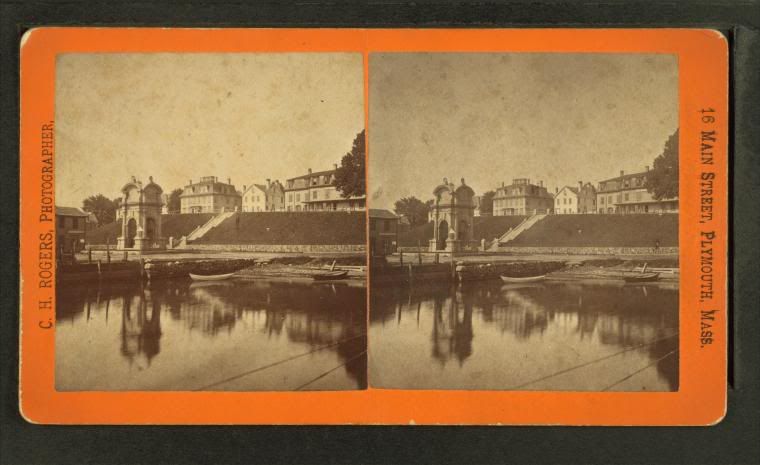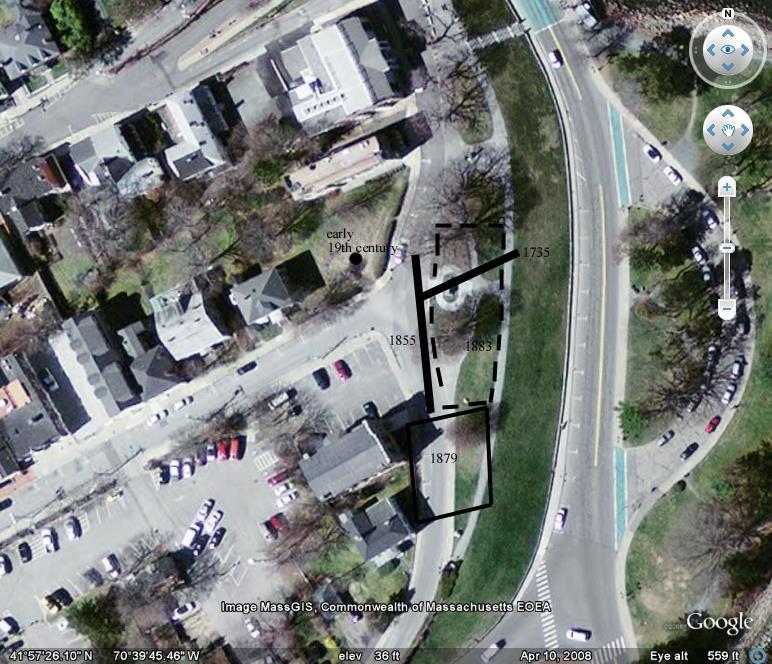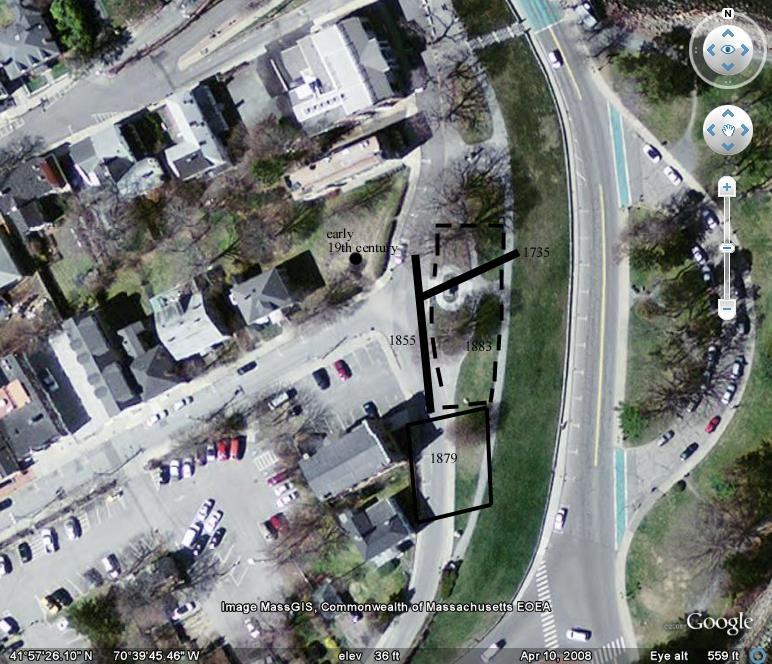What about the possibility of respectfully opening the Sarcophagus on Burial Hill and using modern forensic techniques (possibly DNA testing and forensic facial reconstruction) to get the bones contained within to speak to us after all these centuries? If it was determined that those remains were actually from the people who died the first winter, it would be like they did not die in vain if they could tell us their stories. Imagine coming face to face with one of the actual First Comers. Of course, if you used DNA testing and identified to whom the bones belonged, would that mean that living descendants would want to have the bones repatriated for reburial?


Could these be Native burials instead of historic? The situation of the burials is right for Native grave and no forensic analysis has ever really been done.
James Thacher’s History of the Town of Plymouth (1832) was the first published source, known to this author at least, to discuss the human remains that had been discovered on Cole’s Hill. On page 29 Thacher is the first to identify the area as being the location of the first burial ground.
“The place in which the settlers first located themselves for a town, is the whole extent of our Leyden street and its environs. This street was laid out by them when planning the town, and extends from the town square in a gradual descent to the shore, and terminates a little distance south of the memorable rock. During the first winter, the settlers buried their dead on the banks of the shore, since called Cole’s Hill, near their own dwellings, taking special care by levelling the earth to conceal from the Indians the number and frequency of deaths. Dr. Holmes mentions a tradition, that the graves at that spot, after the great mortality in the first stage of the settlement, were levelled and sown over by the settlers to conceal the extent of their loss from the natives. An aged gentleman, Hon. Ephraim Spooner, since deceased, who gave this information to Dr. Holmes, received it from Elder Faunce, who died 1745, in the 99th year of his age, and who was well acquainted with some of the first settlers. Hon. Judge Davis relates that he has often had similar information from an aged lady, Mrs. White, who died at Plymouth, a few years since, and who, in early life, was intimate in the family of Elder Faunce. It has always been supposed that the remains of Governor Carver were deposited on Cole’s Hill, and it is to be regretted that no stone was erected to designate the spot.” (Thacher 1832: 29).
Thacher was the first historian to record the tradition that was related to him by Dr. Holmes, that after the dead were buried, the ground was leveled and then planted to conceal the graves from the Natives (so that the Natives would not know how many died and thus how potentially weak the colony was). Holmes said that he received the information from the Honorable. Ephraim Spooner, who received it from Elder Faunce (the same person who identified Plymouth Rock as being the venerable artifact that the colonists first set foot on). Apparently a bit of the telephone game. Faunce, who died in 1745, would have been in Plymouth in 1735 when a great flood down Cole’s Hill washed human remains out of the hillside:
“In the year 1735, a severe storm occurred, and large quantities of water rushing through Middle street, washed away some portion of the banks, carrying in its current the remains of several bodies, deposited there in the winter of 1620, and spring of 1621. In the year 1809, a human skull was disinterred, the teeth of which were in a perfect state of preservation. The traditions respecting this place, and its consecrated uses by the Pilgrims, were received from the same unquestionable sources, as are mentioned in the account of Forefather’s Rock on page 176 of this work, and are stated by Dr. Holmes, in his American Annals, and by the venerable Judge Davis, in a note to his edition of the New England Memorial, to have been received by them many years ago.” (Russell 1846: 200)
In the fifth edition of Russell’s Guide to Plymouth (1870) he gives even more detail on the burials and an investigation led by Oliver Wedell Holmes:
“Cole’s Hill is an open green spot fronting the harbor, a short distance above Forefather’s Rock, commanding a beautiful view of the ocean and highlands by which the bay is encircled. It was the first burial-ground of the Pilgrims. On inspection it will be found to have undergone considerable changes since its first consecration as a temporary receptacle of the dead. In the year 1735, a large current of water, rushing through Middle-street, washed away some portions of the banks, displacing the remains of several bodies, deposited there in the winter of 1620 and spring of 1621. In the year 1809, a human skull was disinterred, the teeth of which were in a perfect state of preservation. The traditions respecting this place, and its consecrated uses by the Pilgrims, were received from the same unquestionable sources as are mentioned in the account of Forefather’s Rock, on page nineteenth of this work, and are stated by Dr. Holmes, in his American Annals, and by the venerable Judge Davis, in a note to his edition of the New England Memorial, to have been received by them many years ago.
About fifty of those who came in the Mayflower were buried on this spot, near the foot of Middle-street. Among them were Gov. Carver, William White, Rose Standish, the wife of Captain Standish; Elizabeth, the wife of Edward Winslow, Christopher Martin, William Mullins, John and Edward Tilley, Thomas Rogers, Mary, the wife of Isaac Allerton.
On the twenty-third day of May, 1855, some workmen, while excavating a trench for the pipes of the water-works, exhumed parts of five skeletons. The exact spot of their discovery was the space in the middle of the road upon Cole’s Hill lying between the two points, five rods south, and two rods north, of the foot of Middle-street. Some of the bones laid bare by the workmen were replaced in the trench, and the remainder collected by the town authorities for the purpose of verifying their identity as bones of the Pilgrims, and giving them a proper interment. One of the skulls was placed in the hands of Professor Oliver W. Holmes, of Boston, for examination, who, after a critical comparison with specimens in the cabinet of the Massachusetts Medical College, pronounced it a Caucasian skull, and thus, without doubt, the skull of one of the earliest settlers of Plymouth. History informs us that the place of interment was sown, and carefully levelled, in order to conceal their bones from the knowledge of the natives.
One skull, as demonstrated by the upper jaw, which displayed a beautiful set of teeth, and the wisdom-teeth just emerging from the bone, was that of a young person between seventeen and twenty-five, and of a young man, as other characteristics, the size of the teeth, the width of the ankle, &c., indicated.
The spot where the remains were found is now level, but was originally a slope, which was filled up for the purpose of a road. A foot and a half beneath the surface a stratum of black soil was exposed overlying the bones, and confirming the tradition that the place had been cultivated by the Pilgrims. The bodies had been buried in a horizontal position, with the heads to the west, and lying upon their backs. No traces of coffins were found,— a circumstance, considering the period of the interment, casting no doubt upon the identity of the remains, as the absence of beads, pipes, arrow-heads, &c., rendered it certain that they were not those of Indians.” (Russell 1870: 84-85)
“In a storm of 1735 a torrent pouring down Middle Street made a ravine in Cole’s Hill and washed many human remains down into the harbor. In 1809 a skull with especially fine teeth was exposed. In 1855 these graves were exposed in laying the public conduit on Cole’s Hill. In one grave lay two skeletons, pronounced by surgeons male and female. The man had a particularly noble forehead; and it was fondly surmised that here were the remains of Mr. and Mrs. Carver. These found a new grave on Burial Hill; but the other relics, with barbaric taste, were placed in the top of the stone canopy over Forefathers’ Rock. In 1879, during some work on the southeast side of the hill, many more bones were unearthed, and some, with questionable taste, were carried away by the spectators in remembrance of their “renowned sires”… (These bodies were all found with their feet to the east.)” (Goodwin 1878: 158)
“In 1735, during a heavy storm, the bank of the hill was washed away at the foot of Middle Street, and several bodies were exhumed, though not, so far as is known, preserved. In the early part of the century, while digging the cellar of the Jackson House, on the corner of Middle Street, workmen found part of a skeleton, which also failed to be preserved. On the 23rd of May 1855, workmen engaged in digging a trench for the pipes for the Plymouth water-works discovered parts of five skeletons between the two points, five rods south and two rods north of the foot of Middle Street. The writer, then chairman of the board of selectmen, took them in charge, and placing them in a box lined with lead, deposited them in a brick vault on the summit of Burial Hill. Before disposing of the remains he submitted two of the skulls to the distinguished surgeons, the late John C. Warren, and Professor Oliver Wendell Holmes, for a critical examination, and received from them a signed certificate that they belonged to the Caucasian race. When the canopy over Plymouth Rock was approaching completion, its vacant chamber was thought to be a fit place for their permanent preservation, and there the box with its contents was finally deposited. On the 8th of October, 1883, while digging holes for the stone posts of the fence on the hill, workmen found another body, and on the 27th of the following month still another, which it also fell to the lot of the writer to take in charge. The bones of the former were placed in a lead box and deposited in a brick vault on the spot of the original burial, while the bones of the latter were permitted to remain undisturbed as they lay in their grave. Over the brick vault a handsome granite tablet has been recently placed, bearing the following inscription:
“ON THIS HILL.
THE PILGRIMS
WHO DIED THE FIRST WINTER
WERE BURIED.
THIS TABLET
MARKS THE SPOT WERE
LIES THE BODY OF ONE FOUND
Oct. 8th, 1883. THE BODY OF ANOTHER
ANOTHER FOUND ON THE 27TH
OF THE FOLLOWING MONTH
LIES 8 FEET NORTHWEST OF
THE WESTERLY CORNER
OF THIS STONE.
ERECTED 1884.”
(Hurd 1884: 131-132)
Burial Information
On six separate occasions burials have been accidentally uncovered on Cole’s Hill.
1: 1735
A great torrent of water rushed down Middle Street in 1735 and created a gully through Cole’s Hill. At least two skeletons, buried together, were exposed. The local surgeon identified them as a male and a female and for some unknown reason, speculation was that they represented John Carver and his wife, both of whom died in the 1621. These remains wee collected and reburied somewhere on Burial Hill.
2: 1855
Workmen laying water pipes along Carver Street uncovered a total of five graves within a 115.5′ long trench. In an early bit of forensics work, one skeleton was determined to be of a young man between 17 and 25 years old (age was based on the fact that his wisdom teeth were just emerging). It was noted that the burials were located one and one half feet beneath a buried topsoil horizon (which was determined to be proof that crops were planted on top of them). The burials were oriented east to west with their heads to the west and were not buried in coffins, more proof of an early and hasty burial. No grave goods were recorded. This point, as well as the orientation and placement of the dead, supports the idea that they were early historic period graves versus Native graves. The bones were placed in a lead box and deposited in a brick crypt on the summit of Burial Hill. Once the canopy was completed over Plymouth Rock, the box was removed and placed in the canopy.
3: 1879
Work being conducted somewhere on the southeast side of the hill uncovered more graves in 1879. Unfortunately it was not noted where exactly they were found but they did record that their feet were oriented to the east (thus their heads to the west like the other graves). These remains were also put into the Rock canopy.
4: Early 19th century
In the early nineteenth century remains were encountered when the cellar of the Jackson house, which was located on the corner of Middle and Carver streets, was being dug. Parts of one skeleton were encountered, but were not preserved.
5: October 8, 1883
A fence was erected on Cole’s Hill in 1883 and during the digging of the holes for the stone fence posts, another body was encountered. These remains were placed in a lead box and reburied on the same location within a brick vault. A marker tablet was placed on the surface above the vault.
6: November 27, 1883
In November of the same year another body was encountered eight feet northwest of the western corner of the earlier burial.
These are the burials that were found:
1: 2 bodies
2: 5 bodies
3: at least 1
4: 1 burial
5: 1 burial
6: 1 burial
Total: at least 11 bodies in an area measuring 274 feet north to south by 117 feet east to west
If we plot out the locations of these burials, here is where they would have been located

Cole’s Hill References
Goodwin, John A.
1879 The Pilgrim Republic.
Hurd, D. Hamilton
1884 History of Plymouth County, Massachusetts with Biographical Sketches of Many of its Pioneers and Prominent Men. J.W. Lewis and Co., Philadelphia.
Russell, William Shaw
1870 Pilgrim Memorials, and a Guide to Plymouth. Fifth Edition, Crosby and Damrell, Boston, Ma.
1846 Guide to Plymouth and Recollections of the Pilgrims. Published for the author by George Coolidge, Boston, MA.
What about the possibility of respectfully opening the Sarcophagus on Burial Hill and using modern forensic techniques (possibly DNA testing and forensic facial reconstruction) to get the bones contained within to speak to us after all these centuries? If it was determined that those remains were actually from the people who died the first winter, it would be like they did not die in vain if they could tell us their stories. Imagine coming face to face with one of the actual First Comers. Of course, if you used DNA testing and identified to whom the bones belonged, would that mean that living descendants would want to have the bones repatriated for reburial?
Service Unavailable
The server is temporarily unable to service your request due to maintenance downtime or capacity problems. Please try again later.
Additionally, a 503 Service Unavailable error was encountered while trying to use an ErrorDocument to handle the request.